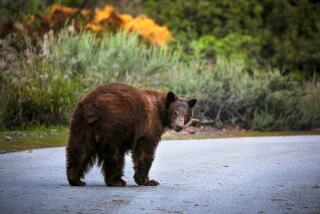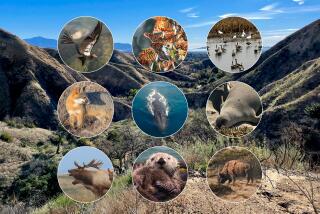Shooting Wildlife--Ready, Aim . . . Click
- Share via
Some people and organizations with an interest in the outdoors flatly oppose sport hunting. Others, including the Sierra Club and Audubon Society, take a neutral stand.
But most of those who oppose sport hunting or remain neutral believe that hunting itself is just fine--as long as it’s not done with a bow or a gun. Wildlife photographers, for instance, say shooting a deer with a camera demands more patience and knowledge of animal behavior and wood lore than shooting a deer with a gun.
A good wildlife photographer is a skilled stalker with a steady hand, explained Mark Palmer, the chairman of the Sierra Club’s National Wildlife Committee. “You’re trying to get closer to the animal, often closer than the sport hunter gets,” Palmer said.
Palmer recalls a morning in Yellowstone National Park, and a moose that was getting closer by the second. “He charged--a big guy, running stiff-legged straight at me.”
Reluctantly, Palmer stood his ground. The moose stopped. Palmer fired off some frames.
“With photography, the reward is capturing an undisturbed animal relating to its environment. The trophy you hang on the wall is a photograph rather than a stuffed head. . . .”
Another breed of hunter pursues his prey armed only with binoculars.
“It’s not enough to look at these creatures on television--”Wild Kingdom” or whatever--or to look at pictures. That’s great. But to see the real thing is a different order of reality,” explained Sandy Wohlgemuth, an avid “birder” who writes a conservation column for the Los Angeles Audubon Society’s newsletter.
Other people say that the best way to enjoy wildlife is just to enjoy the outdoors, and be ready to watch when animals appear.
“I can see the excitement of the hunt--pitting wits against wild creatures,” said David Brower, the founder of Friends of the Earth and current chairman of the Earth Island Institute. “If I needed to hunt for food I would. But I don’t. I don’t see how someone can get pleasure out of shooting something beautiful out of the sky and watching it fall.”
For him just seeing an animal in the wilds is thrill enough, Brower said.
To express his feelings, he quoted nature writer Henry Beston:
“In a world older and more complete than ours, they (wild creatures)move finished and complete, gifted with extensions of the senses we have lost or never attained, living by voices we shall never hear.
“They are not brethren, they are not underlings;they are . . . caught with ourselves in the net of life and time, fellow prisoners of the splendor and travail of the earth.”
Among the most exciting moments of her life were those spent watching wildlife, said Jo Stallard, president of the Monterey Peninsula Audubon Society.
Stallard has felt a surge of adrenaline watching a golden eagle attack a California condor, and has experienced the “sheer pleasure of watching a mountain lion come down the side of a mountain,” she said.
One of her most vivid recollections is of crouching behind a tree for more than an hour as coyotes hunted mice in a field near Big Sur.
“The mice were underground, and very difficult to catch. So the coyotes kept tippy-toeing, then leaping. Tippy-toeing, then leaping. . . . It was a joyful and beautiful thing to watch. The lupines and poppies were blooming in the field, and the coyotes were part of it. They belonged there.
” . . . I never see a bird fly that it doesn’t absolutely amaze me. My whole heart and soul flies. I can enjoy all the things they can do by watching them, by letting them be themselves. It’s a great privilege and honor to share the world with animals.


